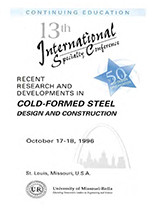Session Dates
17 Oct 1996
Abstract
A new cold-formed and resistance welded section known as the Hollow Flange Beam (HFB) has been developed recently in Australia. In contrast to the common lateral torsional buckling mode of I-beams, this unique section comprising two stiff triangular flanges and a slender web is susceptible to a lateral distortional buckling mode of failure involving lateral deflection, twist, and cross-section change due to web distortion. This lateral distortional buckling behavior has been shown to cause significant reduction of the available flexural capacity of HFBs. An investigation using finite element analyses and large scale experiments was carried out into the use of transverse web plate stiffeners to improve the lateral buckling capacity of HFBs. This paper presents the details of the finite element model and analytical results. The experimental procedure and results are outlined in a companion paper at this conference.
Department(s)
Civil, Architectural and Environmental Engineering
Research Center/Lab(s)
Wei-Wen Yu Center for Cold-Formed Steel Structures
Meeting Name
13th International Specialty Conference on Cold-Formed Steel Structures
Publisher
University of Missouri--Rolla
Document Version
Final Version
Rights
© 1996 University of Missouri--Rolla, All rights reserved.
Document Type
Article - Conference proceedings
File Type
text
Language
English
Recommended Citation
Avery, P. and Mahendran, Mahen, "Finite Element Analysis of Hollow Flange Beams with Web Stiffeners" (1996). CCFSS Proceedings of International Specialty Conference on Cold-Formed Steel Structures (1971 - 2018). 5.
https://scholarsmine.mst.edu/isccss/13iccfss/13iccfss-session3/5
Finite Element Analysis of Hollow Flange Beams with Web Stiffeners
A new cold-formed and resistance welded section known as the Hollow Flange Beam (HFB) has been developed recently in Australia. In contrast to the common lateral torsional buckling mode of I-beams, this unique section comprising two stiff triangular flanges and a slender web is susceptible to a lateral distortional buckling mode of failure involving lateral deflection, twist, and cross-section change due to web distortion. This lateral distortional buckling behavior has been shown to cause significant reduction of the available flexural capacity of HFBs. An investigation using finite element analyses and large scale experiments was carried out into the use of transverse web plate stiffeners to improve the lateral buckling capacity of HFBs. This paper presents the details of the finite element model and analytical results. The experimental procedure and results are outlined in a companion paper at this conference.



